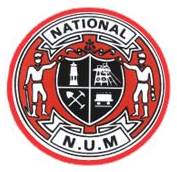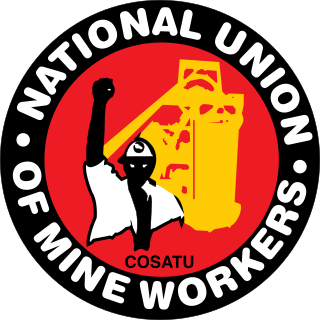Related Research Articles

Northern Rhodesia was a protectorate in south central Africa, formed in 1911 by amalgamating the two earlier protectorates of Barotziland-North-Western Rhodesia and North-Eastern Rhodesia. It was initially administered, as were the two earlier protectorates, by the British South Africa Company (BSAC), a chartered company, on behalf of the British Government. From 1924, it was administered by the British Government as a protectorate, under similar conditions to other British-administered protectorates, and the special provisions required when it was administered by BSAC were terminated.

The National Union of Mineworkers (NUM) is a trade union for coal miners in Great Britain, formed in 1945 from the Miners' Federation of Great Britain (MFGB). The NUM took part in three national miners' strikes, in 1972, 1974 and 1984–85. After the 1984–85 strike and the subsequent closure of most of Britain's coal mines, it became a much smaller union. It had around 170,000 members when Arthur Scargill became leader in 1981, a figure which had fallen in 2015 to an active membership of around 100.
The British South Africa Company was chartered in 1889 following the amalgamation of Cecil Rhodes' Central Search Association and the London-based Exploring Company Ltd, which had originally competed to exploit the expected mineral wealth of Mashonaland but united because of common economic interests and to secure British government backing. The company received a Royal Charter modelled on that of the British East India Company. Its first directors included The 2nd Duke of Abercorn, Rhodes himself and the South African financier Alfred Beit. Rhodes hoped BSAC would promote colonisation and economic exploitation across much of south-central Africa, as part of the "Scramble for Africa". However, his main focus was south of the Zambezi, in Mashonaland and the coastal areas to its east, from which he believed the Portuguese could be removed by payment or force, and in the Transvaal, which he hoped would return to British control.

The Australian Workers Union (AWU) is one of Australia's largest and oldest trade unions. It traces its origins to unions founded in the pastoral and mining industries in the 1880s and currently has approximately 100,000 members. It has exercised an influence on the Australian trade union movement and on the Australian Labor Party throughout its history.

Kabwe is the capital of the Zambian Central Province with a population estimated at 202,914 at the 2010 census. Named Broken Hill until 1966, it was founded when lead and zinc deposits were discovered in 1902. Kabwe also has a claim to being the birthplace of Zambian politics as it was an important political centre during the colonial period. It is an important transportation and mining centre.
The Copperbelt strike of May 1935 was a strike by African mineworkers in the Copperbelt Province of Northern Rhodesia on 29 May 1935 to protest taxes levied by the British colonial administration. The strike involved three of the province's four major copper mines: those in Mufulira, Nkana and Roan Antelope. Near the latter, six protesters were killed by police and the strike ended. Although it failed, the strike was the first organized industrial agitation in Northern Rhodesia and is viewed by some as the first overt action against colonial rule. It caught the attention of a number of African townsmen, leading to the creation of trade unions and African nationalist politics, and is seen as the birth of African nationalism.
The Miners' Federation of Great Britain (MFGB) was established after a meeting of local mining trade unions in Newport, Wales in 1888. The federation was formed to represent and co-ordinate the affairs of local and regional miners' unions in England, Scotland and Wales whose associations remained largely autonomous. At its peak, the federation represented nearly one million workers. It was reorganised into the National Union of Mineworkers in 1945.

The National Union of Mineworkers (NUM) is a trade union in South Africa. With a membership of 300,000 it is the largest affiliate of the Congress of South African Trade Unions. It was founded in 1982 as a black mine workers union by Cyril Ramaphosa and grew rapidly, winning bargaining recognition from the Chamber of Mines in 1983.
Trade unions in South Africa have a history dating back to the 1880s. From the beginning unions could be viewed as a reflection of the racial disunity of the country, with the earliest unions being predominantly for white workers. Through the turbulent years of 1948–1991 trade unions played an important part in developing political and economic resistance, and eventually were one of the driving forces in realising the transition to an inclusive democratic government.
The African Mine Workers' Strike was a labour dispute involving mine workers of Witwatersrand in South Africa. It started on 12 August, 1946 and lasted approximately a week. The strike was attacked by police and over the week, at least 1,248 workers were wounded and at least 9 killed.
Lawrence Chola Katilungu was a Northern Rhodesian trade union leader. Katilungu was the first President of the African Mineworkers' Union.
The Dalgleish Report was a governmental report produced by the Dalgleish Commission, a commission of inquiry established in 1947 to investigate industrial relations in the mining industry of Northern Rhodesia. In particular the Commission suggested possible reforms to the industrial colour bar, a system of segregation which reserved certain occupations for European mineworkers.
The Northern Rhodesia Police was the police force of the British ruled protectorate of Northern Rhodesia.

The National Union of Scottish Mineworkers (NUSW) is a trade union in Scotland, founded in 1894 as the Scottish Miners Federation. It joined the Miners' Federation of Great Britain, and in 1914 changed its name to National Union of Scottish Mineworkers. It survives as the National Union of Mineworkers.

The history of rail transport in Zambia began at the start of the twentieth century.
The Northern Rhodesian African Mineworkers' Union (A.M.U.) was a trade union in Northern Rhodesia which represented black African miners in the Copperbelt. The AMU was formed in 1949, and campaigned actively to improve working conditions and wages for African miners, as well as opposing racial discrimination in hiring. The union amalgamated with several other mining unions in 1967 to form the Mineworkers' Union of Zambia.

The Workers and Socialist Party (WASP) is a Marxist and Trotskyist political party in South Africa affiliated to the International Socialist Alternative.
The Rhodesian Railway Workers' Union (R.R.W.U.) was a trade union in Rhodesia which represented European railway workers employed by the Rhodesian Railways.
The Mines African Staff Association (MASA) was a Northern Rhodesian trade union which existed between 1953 and 1967. It represented black African salaried employees in Northern Rhodesia's mining industry.
Matthew Mwendapole was a Northern Rhodesian trade union leader.
References
- 1 2 3 4 Berger, Elena L. (1974). Labour, Race and Colonial Rule: The Copperbelt from 1924 to Independence . Oxford Studies in African Affairs. Oxford: Clarendon Press. ISBN 0 19 821690 4 . Retrieved 2013-09-26.
- 1 2 3 Philip Murphy (2005). British Documents on the End of Empire: Central Africa, Part I. The Stationery Office. pp. lvi, 7. ISBN 978-0-11-290586-8.